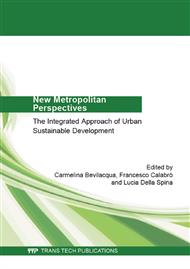[1]
Commission of the European Communities (CEC) (2013). State of the Innovation Union 2012 - Accelerating change. Brussels: Commission of the European Communities, COM (2013), 149 final.
Google Scholar
[2]
M. B. Jensen, B. Johnson, E. Lorenz and B. A.: LundvallForms of knowledge and modes of innovation. In: Research Policy, 36, (2007), p.680–693.
Google Scholar
[3]
A. Arundel, C. Bordoy, M. Kanerva: Neglected innovators: how do innovative firms that do not perform R&D innovate? Results of an analysis of the Innobarometer 2007 survey, nº 215. INNO-Metrics Thematic Paper, European Commission, DG Enterprise, Brussels, 31 March (2008).
Google Scholar
[4]
E. Kirner, S. Kinkel, A. Jaeger: Innovation paths and the innovation performance of low-technology-firms – an empirical analysis of German industry. In: Research Policy, 38, (2009), pp.447-458.
DOI: 10.1016/j.respol.2008.10.011
Google Scholar
[5]
J.L. Hervas-Oliver, J. Albors-Garrigos, J. J.: Baixauli Beyond R&D activities: the determinants of firms' absorptive capacity explaining the access to scientific institutes in low medium-tech contexts. In: Economics of Innovation and New Technology, 21, (2011).
DOI: 10.1080/10438599.2011.555113
Google Scholar
[6]
C. S. Pereira, F. C. Romero: Non-technological Innovation: Current Issues and Perspectives. In: Independent Journal of Management & Production, 4, (2013), pp.360-376.
Google Scholar
[7]
A. Trigo: The nature of innovation in R&D- and Non-R&D-intensive service firms: Evidence from firm-level latent class analysis. In: Industry and Innovation, 20, (2013), pp.48-68.
DOI: 10.1080/13662716.2013.761380
Google Scholar
[8]
H. Boer, W.: During, Innovation, what Innovation? A Comparison between Product, Process and Organisational Innovation. In: International Journal of Technology Management, 22, (2001), pp.83-109.
DOI: 10.1504/ijtm.2001.002956
Google Scholar
[9]
A. M. Baranano: The non-technological side of technological innovation: State-of-the-art and guidelines for further empirical research. In: International Journal of Entrepreneurship and Innovation Management, 3, (2003), pp.107-125.
DOI: 10.1504/ijeim.2003.002223
Google Scholar
[10]
T. Schmidt, C.: Rammer, Non-technological and Technological Innovation: Strange Bedfellows?, ZEW Discussion Paper (2007).
DOI: 10.2139/ssrn.1010301
Google Scholar
[11]
OECD (2010), The OECD Innovation Strategy: getting a head start on tomorrow. OECD, Paris.
DOI: 10.1787/9789264083479-sum-en
Google Scholar
[12]
L. Madureira, T. M. Gamito, D. Ferreira, J. Portela: Inovação em Portugal Rural. Detetar, Medir e Valorizar, Princípia, Lisboa (2013).
Google Scholar
[13]
L. Madureira, T. M. Gamito, D. Ferreira, I. Oliveira: Innovation inputs and processes: the reality out of the box in the Portuguese rural áreas. In: T. Noronha, J. Gomes (org. ): Innovation for sustainability and networks, University of Algarve Book Series(2013).
Google Scholar
[14]
T. M. Gamito, L. Madureira, J. Portela, D.: Ferreira Measurement of good practices of innovation in rural areas. In: T. Noronha, J. Gomes (org. ): Innovation for sustainability and networks, University of Algarve Book Series (2013).
Google Scholar
[15]
G. Brunori, A. Rossi: Synergy and Coherence through Collective Action: Some Insights from Wine Routs in Tuscany. In: Sociologia Ruralis, 40, (2000), pp.409-423.
DOI: 10.1111/1467-9523.00157
Google Scholar
[16]
J. Murdoch: Networks a new paradigm of rural development? In: Journal of Rural Studies, 16, (2000), pp.407-419.
DOI: 10.1016/s0743-0167(00)00022-x
Google Scholar
[17]
A. Copus, D. Skuras: Business Networks and Innovation in Selected Lagging Areas of the European Union: A Spatial Perspective. In: European Planning Studies, 14, (2006), pp.79-92.
DOI: 10.1080/09654310500339885
Google Scholar
[18]
G. Thiele, A. Devaux, I. Reimoso, H. Pico, F. Montesdeoca, M. Pumisacho, J. A. Piedra, C. Veloso, P. Flores, R. Esprella, A. Thomann, K. Manrique, D.: Horton Multi-stakeholder platforms for linking small farmers to value chains: evidence from the Andes. In: International Journal of Agricultural Sustainability, 9, (2011).
DOI: 10.1080/14735903.2011.589206
Google Scholar


